Private Scuba Divers › PADI Courses › Freediving › Gear
Equipment Used in Freediving
The specialised gear and accessories that freedivers use needs to be more robust and better quality than the basic sets that recreational snorkelers wear.
This section contains an extensive list of freediving equipment and extra safety items that allow you to dive deeper - and for longer.
Freediving Equipment | Table of Contents
- Freediving Masks and Goggles (including Fluid Goggles)
- Long Blade Fins and Monofins
- Floats, Lines, and Safety Lanyards
- Computers and Watches for Freedivers
- Freediving Dive Knife: Necessary or Not?
- Snorkels and Nose-clips
- Weight Belt and Weights (including neck weights)
- Wetsuits and Swimming Caps
So, besides the basic essentials (e.g. a mask, pair of fins, and snorkel) what other equipment do recreational and competitive freedivers use?
Some of the equipment listed below may not be needed by beginners. But, after taking PADI® Freediving courses you will be looking to buy some new gear and gadgets.
Masks and Goggles used by Freedivers
As a beginner, you should not overlook the importance of having the best freediving mask in your kit bag and you should be looking to buy a low volume mask.
Why is that?
One reason is because the air inside the mask starts to compress as you go down, which may result in a 'mask squeeze'. As a result, freedivers who will descend below fifteen (15) metres should be using a low volume mask.
If you go deeper, the water pressure increases and compresses the air spaces inside the mask. Hence, you need to use the proper techniques for equalizing pressure while diving to stop it sucking onto your face and eyeballs.
In short, blowing air through the nose prevents a squeeze. This is why most competition freedivers use the low volume model. In fact, it is not uncommon for the air inside a mask to contain up to 25% of the diver's lung volume.
Most freedivers prefer to wear a mask or goggles that have either a black or a dark coloured skirt (due to the time spent at the surface). If bright sunlight shines through to the inside of the lens (e.g. through a clear or translucent skirt) it can create a reflection that may distract you.
Why Do Freedivers Use Goggles Instead of a Mask?
Some competitive freediving disciplines take place in a swimming pool. As a result, most freedivers choose to use swimming goggles and nose-clips to get the optimum amount of water exposure on their face.
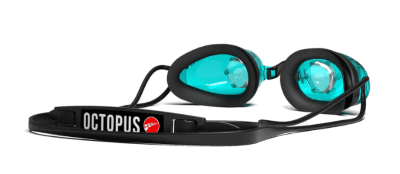 In case you were wondering:
In case you were wondering:
Facial nerves are super sensitive to cold water and it triggers the Mammalian Dive Reflex.
The major benefit for freedivers is an increase in the potential for an extended breathhold dive.
However, wearing goggles for deep diving means you also need to wear a nose-clip.
To the untrained, freediving goggles look like those used in swimming. But, the main difference is having fluid-filled lenses. This feature means divers can save air (no need to equalise fluid goggles) and they can still focus their eyesight in the water.
In truth, water-filled goggles tend to hamper your vision. Even so, it is clear enough for you to recognise a freediving float rope or tag on the bottom plate (if you're performing a competition dive).
Note: Another section contains detailed information about the difference between snorkeling masks and swimming goggles and why you can't go scuba diving with goggles.
Fins and Monofins Used for Freediving
One question beginners ask a lot is 'why are freediving fins so long'. The short and simple answer is to get better propulsion through the water. Hence, wearing longer fins can help freedivers create more speed and power.
When they start a freediving course, we also get asked 'what is the best material for freediving fins'. Even though you can buy cheap fins made from plastic or fibreglass, we recommend carbon fibre freediving fins for their ability to return maximum energy.
So, what are the best footpockets to use? In most cases, comfort is paramount in recreational freediving.
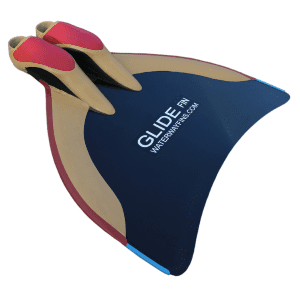 Because we all have different foot structures, you want to make sure the footpockets are the correct shape and not too tight.
Because we all have different foot structures, you want to make sure the footpockets are the correct shape and not too tight.
No matter which style you choose, you will be depending on a blade that has enough flexibility to create maximum thrust.
Why Do Some Freedivers Use Monofins?
This type of swimfin is popular in most underwater sports, including:
- Finswimming
- Free-diving
- Underwater orienteering
One reason why many freedivers use a monofin is because of the efficient way it powers the human body through water.
Pro Tip: Putting blades into footpockets that have rigid side rails is unlikely to produce the best outcome for freedivers.
Freediving Floats, Lines, and Lanyards
In the interest of water safety, recreational freedivers and spearfishers will tow a surface float (e.g. to warn boaters in the area).
Sometimes, it is not easy to see a free diver in the water. So, using a torpedo shaped float that supports a bright coloured flag is advisable.
Moreover, one of the common freediving injuries is blackout (they occur most often in the first ten metres below the surface). That's why freedivers should never dive alone and use a buddy to follow the one up and one down safety procedures.
In a nutshell, using a line and float means the buddy diver can follow it down to the diver below (e.g. when a problem arises and they are not visible from the surface).
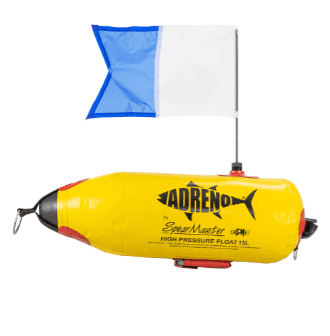 Usually, the rope will be marked off in metres during very deep training and competitions. There will also be a counter-balance system at the surface.
Usually, the rope will be marked off in metres during very deep training and competitions. There will also be a counter-balance system at the surface.
Thus, dropping a weight on one side means you can bring up the bottom weight.
This safety system is used to retrieve deep diving freedivers who fail to show at the surface in an allotted time frame.
How Does a Lanyard Work?
A lanyard is a line that attaches a freediver to the main depth rope.
Freedivers need to be attached to the main rope in professional competitions and in extreme depth training dives.
Thus, if a freediver fails to show up at the surface in the expected time it triggers the counterbalance. This system pulls up the bottom plate and the diver from depth.
In some cases, freedivers go beyond the depth for safety divers to reach them (or descend into dark water with poor visibility).
Important: There are strict requirements for lanyard design and strength. Also, freedivers must be able to release it if they get entangled underwater.
Free Dive Computers and Watches
You may be wondering why a freediver actually needs to have a diving computer? In fact, they are not an absolute necessity when freediving or snorkel swimming in shallow water (e.g. in the ten metre range).
Nonetheless, the importance of knowing your exact depth and duration (e.g. from underwater computers) will increase if you go deeper.
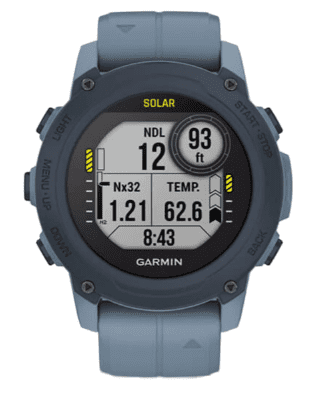 But, the primary purpose of a free-diving computer is monitoring the recovery time at the surface.
But, the primary purpose of a free-diving computer is monitoring the recovery time at the surface.
Free dive computers display the depth and duration of previous dives as they continue ticking off the exact time of a recovery.
You can also set a computer alarm system to give off an audible alert for any given depth.
Freediving and Decompression Sickness
Some freedivers dive deep enough for Decompression Sickness (DCS) to become a serious risk. Thus, monitoring their surface time (compared to a previous dive time) becomes critical.
Note: Freedivers will be diving with two (2) computers during a competition (their own and the competition computer).
Competitors usually wear it on the wrist of the hand that is going to reach for the tag on the base plate. Of course, the reason for this is to get the deepest reading. But, in competition dives, you get penalties for distances that measure short of the target.
Do You Need a Knife to Freedive?
It may puzzle some individuals who are going to start training to freedive, but why would you need to carry a knife?
Most scuba divers will already know that you carry a knife (or diver's tool) for safety, not for an underwater altercation. It is a precaution against diver entanglement with fishing line or trawl nets.
However, carrying a dive knife is not a requirement for competitive freediving or training. Why is that? It is because organisers check the freediving zones for any risks before the divers begin competing.
Note: Another section contains more information about the best diving knife with equipment reviews and expert tips
Nose Clips and Snorkels for Freediving
Even though modern snorkel designs promote ease of use, for safety purposes freedivers will actually drop the snorkel from their mouth while performing a dive.
As a result, most of the time they will choose to use a simple snorkel tube with a comfortable mouthpiece.
Why Do Freedivers Wear Nose Clips?
The main reason freedivers wear a nose clip with goggles is to stop water from penetrating into the nasal and sinus cavities.
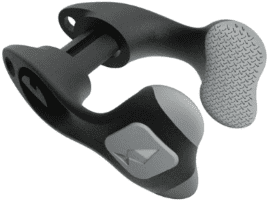 Not only does it help to keep water out of the nose, it also provides additional pressure to equalise the ears.
Not only does it help to keep water out of the nose, it also provides additional pressure to equalise the ears.
Performing deep dives is a lot easier if you don't need to reach up to pinch your nose for equalisation.
Freediving Nose Clip vs. Swimmer Noseplugs
In fact, the nose-clips that freedivers use have several differences to the ones often worn by swimmers.
Swimmers use nose-clips to stop water going inside the nose - usually at the surface where water pressure is low. But, the water pressure increases as a freediver dives deeper. Thus, they need to use a dependable, robust device.
Furthermore, it needs to provide back pressure so the freediver can equalise. A freediver's nose-clip seals the skin all around the nostrils.
This part is important:
One other crucial feature that all freediving nose-clips must have is the ability to remove it 'easily' during competitive performances.
Surface protocol requires freedivers to remove all their facial equipment (mask, goggles, nose clip) for the completion of a dive. They need to complete this task without any mistakes within fifteen (15) seconds of surfacing.
Freediver Weights and Weight Belts
The material used for making weight belts is either rubber or webbing. In general, the superior choice is a rubber belt because of the snug fit. It also stays snug even as the increasing water pressure compresses a human body and a wetsuit.
Most experts agree that a webbing weight belt is quite adequate for anyone performing shallow recreational dives. Even so, its size will not reduce with the biological changes that occur to a freediver while they are experiencing the immense pressures of deep water.
Here's Why Freedivers Use Neck Weights
Having two lungs full of air creates an enormous uplift, So, wearing a neck weight helps you get the correct ballast and achieve a horizontal position (e.g. for swimming).
Most of the time, a freediver will use a neck weight during training, in a swimming pool, and in competition pool disciplines (e.g. Static Apnea).
You may also need to wear weights around your waist if you are wearing a full length wetsuit. You will need some counterbalance to the upthrust that thick neoprene wetsuits deliver to your legs.
Freediving Wetsuits, Caps, and Hoods
If you're lucky to freedive in some of the best diving and snorkeling locations worldwide, you may not even need to wear a wetsuit.
Nonetheless, the primary purpose of a wetsuit is to keep the aquatic athlete warm. Remember, freedivers get a lot of exposure to the Mammalian Dive Reflex (MDR) - and with a greater intensity.
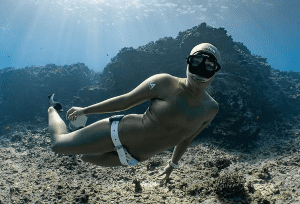 As a result, you may start to experience:
As a result, you may start to experience:
- A lower heart rate
- Restricted circulation to the extremities
- Greater susceptibility to the cold
Freediving wetsuits are usually smooth, much like human skin. The smoothness helps divers go for maximum distance or depth underwater.
Note: Another section explains more about the scuba wetsuit temperature guide with further information about neoprene boots, gloves, and hoods.
Swimming Caps and Hoods
There are several important reasons why freedivers wear a swimming cap or a hood. The most obvious one is for optimum streamlining.
Gaining one metre of distance through a better streamlined body position is a metre you don't physically need to work for.
Often, freedivers wear a thick wetsuit that has an attached hood for colder waters. But, you can buy hoods separately too. Remember, if you're one of the beginners in freediving, and you have long hair (no matter whether you are male or female) you will need to wear something that keeps it out of your face.
Related Information and Help Guides
- Beginners Guide to Freediving | How to Become a Freediver?
- Basic Freediver Certification Explained for Beginners
- How to Get Certified as a PADI Freediver in Thailand?
Disclaimer: The information in this freediving equipment guide does not replace professional tuition that you would get in a sanctioned course. You should never freedive alone or practice holding your breath without a companion.